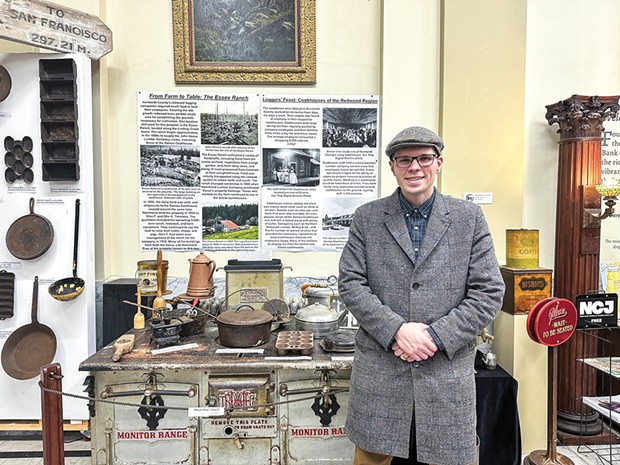An Appetite for Local Food History at the Clarke
By Jennifer Fumiko Cahill [email protected] @jfumikocahill
Photo by Jennifer Fumiko Cahill
Josh Buck by the Samoa Cookhouse stove on display at the Clarke Historical Museum.
[
{
"name": "Top Stories Video Pair",
"insertPoint": "7",
"component": "17087298",
"parentWrapperClass": "fdn-ads-inline-content-block",
"requiredCountToDisplay": "1"
}
]
"You don't think you're going to make much of a sweat working at a museum but moving things around really gets you there," says Josh Buck, executive director-curator of the Clarke Historical Museum. Looking at the behemoth of an iron stove hauled into the main hall from the backroom of the Samoa Cookhouse, it's easy to see how museum staff, board members, volunteers and community members put their backs into the Food and Drink of Humboldt County exhibit running through August. The displays, which feature menus, cookwear, bottles and brands, are a group effort with most items on loan from the community.
Buck says, "We really started with the idea of making an exhibit that shows the process of farm to table," more of a logistical challenge than a chef's ethos in the early days of Humboldt. With the Samoa Cookhouse closed for the next year or so, the Danco Group, which owns the property, loaned the museum some of its kitchen artifacts, like its chopping block and massive ladles. Back when the cookhouse kept loggers fed for heavy labor with a diet that rounded 8,000 calories, Buck explains, supplies came in by rail from the 2,000-acre Essex Ranch near Fieldbrook.
That farm, now held by the Timmons family, is resurrected here with items on loan from Rick Timmons, including brands the ranch used for its cattle. Other cattle brands used by local ranchers are on display, too, including some with which lumber companies marked the animals they used to haul timber.
Those thirsty for local beer history can thank John Scofield for sharing a bottle of Pride of Humboldt beer from 1940, brewed in the company's former home next to where the Bayshore Mall is today. Several local breweries rebranded as soda companies during Prohibition, explains Buck, and some returned to beer once it was legal again. You can peruse the bottles, vintage labels, crates and drink trays, many loaned by collector Jack Nash, he says, including many items from Humboldt Brewing Co., the defunct business from which the Arcata brewer takes its name.
Nash also shared a treasure trove of menus and memorabilia from restaurants long gone. A look in the case reveals the wine list at Lazio's, a plate from the schooner-shaped Shipwreck restaurant that burned to the ground in King Salmon (a piece from Buck's personal collection) and popular eatery Big 4, and a menu confirming that a cheeseburger at Bim's was indeed $0.85.
"The amount of people who come in and you just see the smile on their faces," marvels Buck. "They have memories of all these restaurants."
The exhibit in Nealis Hall curated by Jasmine Brown focuses on Indigenous food production and includes mostly materials from the Clarke's collection, like a large eel trap basket and acorn processing tools, as well as information on traditional food access. Pro tip: Visit during Arts Alive and a Native expert will demonstrate a traditional skill — you may even get to try your hand at it. On Feb. 3, Board Member Shirley Laos (Yurok, Karuk, Chetco) and her granddaughter Isobel were demonstrating pine nut processing for making regalia.
A quick turn in the Victorian exhibit will give you a peek at some vintage kitchen implements and a lesson on the importance of regulation. Apparently, as foods became more processed, manufacturers were using fillers, some of them known to be toxic, like lead chromate in mustard and mercury in confections, to bulk up their products. "The one that really got me was plaster of Paris being used" in bread, says Buck.
Clarke Historical Museum members can expect two more panels with local food and drink experts like the one that preceded the opening of the exhibit. (Memberships start at $25 for students and seniors, and $55 for households.) Buck promises food and drink will accompany the panel discussions — all local, no mercury.
Jennifer Fumiko Cahill (she/her) is the arts and features editor at the Journal. Reach her at (707) 442-1400, extension 320, or [email protected]. Follow her on Instagram @JFumikoCahill.
more from the author
-
Failed Leadership
- May 1, 2024
-
Hole Food
- Apr 27, 2024
-
SCOTUS on the Homeless, CPH Protest and Local Entertainment
- Apr 26, 2024
- More »
































